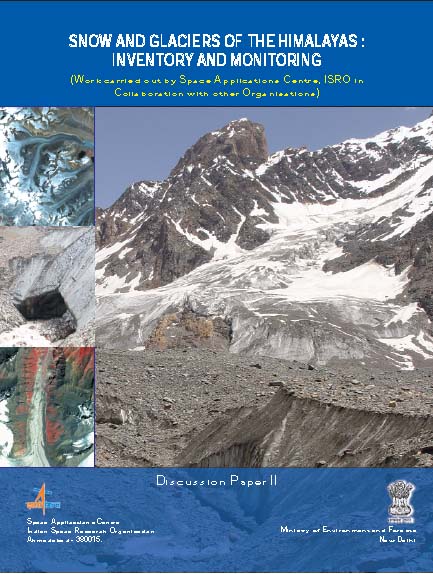Research Papers
Snow and glaciers of the Himalayas – A study by Indian Space Research Organisation
Posted on 14 Jun, 2011 07:58 PM The study on “Snow and Glacier Studies” was taken up by the Space Applications Centre, Indian Space Research Organisation (ISRO) and executed in collaboration with fourteen research organizations and academic institutions of the country, at the behest of the Ministry of Environment and Forests.
The study on “Snow and Glacier Studies” was taken up by the Space Applications Centre, Indian Space Research Organisation (ISRO) and executed in collaboration with fourteen research organizations and academic institutions of the country, at the behest of the Ministry of Environment and Forests.
Himalayan mountains contain important natural resources of frozen fresh water in the form of snow and glaciers. These glaciers are unique as they are located in tropics, high altitude regions, predominantly valley type and many are covered with debris.
The great northern plains of India sustain on the perennial melt of snow and glaciers meeting the water requirements of agriculture, industries, domestic sector even in the months of summer when large tracts of the country go dry. Therefore, it is important to monitor and assess the state of snow and glaciers and to know the sustainability of glaciers in view of changing global scenarios of climate and water security of the nation. Any information pertaining to Himalayan glaciers is normally difficult to be obtained by conventional means due to its harsh weather and rugged terrains.
Study of water supply & sanitation practices in India using geographic information systems - Some design & other considerations in a village setting - IJMR research paper
Posted on 06 Jun, 2011 05:01 PMThe study attempted to understand the phenomenon of water contamination in the village by using GIS as a tool to locate and map water supply and sewage distribution systems in the village, in relation to human and animal dwellings, their wastes, sanitary practices and their connections with drinking water quality for a clearer understanding of the connections between these factors and possible
Weather variability and rainfall pattern of Sidr, the post-monsoon cyclonic storm of November 2007 in the Meghalaya Plateau – A paper in Current Science
Posted on 25 May, 2011 07:52 PMAtmospheric depressions sometimes initiate tropical cyclones in the pre- and post-monsoon season in the Bay of Bengal, which move to land and create havoc. Their intensity and pattern vary individually.
A perspective of watershed development in the central Himalayan state of Uttarakhand – A paper by Malavika Chauhan
Posted on 25 May, 2011 08:23 AMIt traces the historical growth of thinking on watershed in the region, and highlights issues and influences. Impacts and benefits are discussed in relation to sustainability. The review shows that success in these projects is usually isolated, mostly seen in small micro-watersheds with naturally good water harvesting conditions.
Soil respiration under different forest species in the riparian buffer of the semi-arid region of northwest India – A paper in Current Science
Posted on 21 May, 2011 09:44 AMSoil respiration is a major process affecting the global carbon cycle and nutrient flux in the terrestrial ecosystem. It is the major pathway for exchange of gases from soil to atmosphere, influencing atmospheric temperature and ultimately contributing to global warming.
Now it is water all the way in Garhkundar–Dabar watershed of drought-prone semi-arid Bundelkhand – A paper in Current Science
Posted on 19 May, 2011 08:07 AMThe area suffers from water scarcity, natural resource degradation, low crop productivity (1–1.5 t/ha), low rainwater use efficiency (35–45 per cent), high erosion, poor soil fertility, frequent droughts, poor irrigation facilities, heavy biotic pressure on forests, inadequate vegetation cover and frequent crop failure resulting in scarcity of food, fodder and fuel. The region has serious limitations of ground and surface-water availability and heavily depends upon perched water for drinking as well as irrigation.
Recession and reconstruction of Milam Glacier in Kumaon Himalaya – A paper in Current Science
Posted on 18 May, 2011 07:29 PMHimalaya is one of the youngest mountain systems on Earth, and has a direct influence on the climate, hydrology and environment of the Indian subcontinent. It is the abode of one of the world’s largest and mostly inaccessible area of glaciers outside the polar region and provides glacier-stored water to the major Indian river basins. Many of the Himalayan rivers are fed by snow and ice melt run-off from snow fields and glaciers.
Gujarat’s agricultural growth story: Reality check and important lessons for water management – A paper by Institute for Resource Analysis and Policy
Posted on 13 May, 2011 07:57 PMThe agricultural ‘growth’ seen in the recent past in Gujarat is nothing but a good recovery from a major dip in production occurred during the drought years of 1999 and 2000, because of four consecutive years of successful monsoon and bulk water transfer through the Sardar Sarovar project. The real ‘miracle growth’ in Gujarat’s agriculture appears to have occurred during the period from 1988 to 1998.
Future water solutions for India - a paper by Himanshu Thakkar in the Palgrave Development journal
Posted on 13 May, 2011 03:58 PMThis paper by Himanshu Thakkar published in the journal Development looks at the daunting challenges that future water demand places on India a